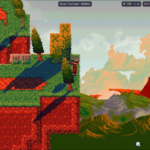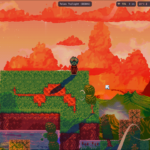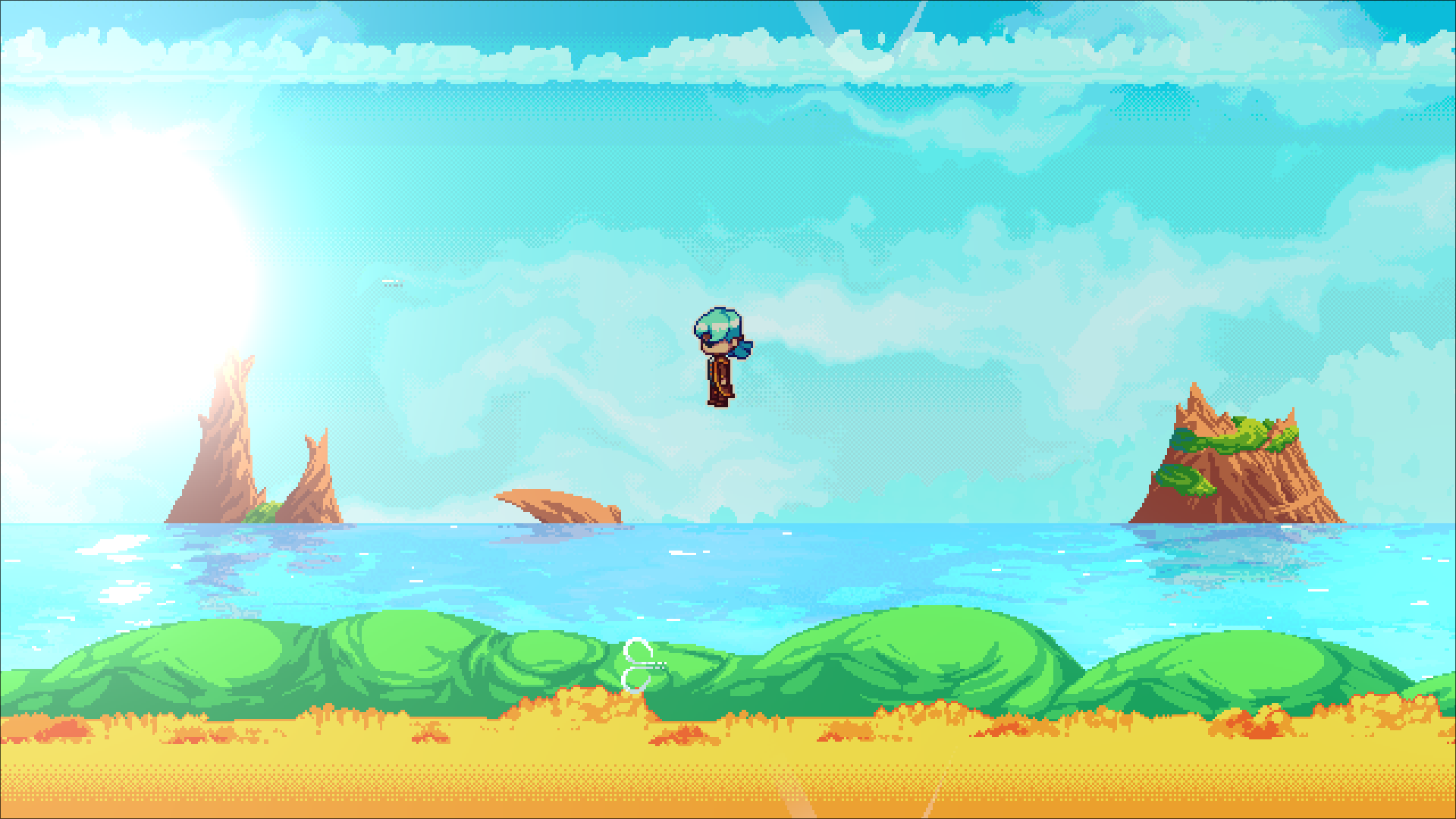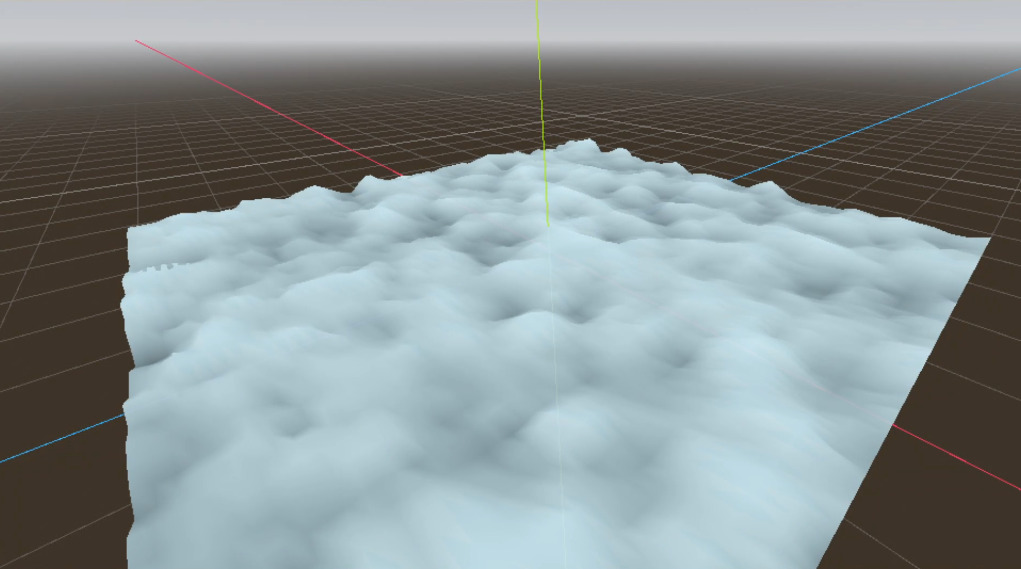Pixel Cloud Shader
Produces pixel art style clouds for use in a parallax backdrop.
This shader uses global variables, which may be adopted in a global time of day/weather system or may be dropped for regular uniforms. Either way, I would recommend these default values for the global variables for sunny weather/afternoon lighting:
“`
WORLD_HORIZON_COLOUR = #42d6d6
WORLD_LIGHT = #ffffe6
WORLD_SKY_COLOUR = #1469c4
WORLD_CLOUD_ENERGY = 1.33
WORLD_CLOUD_VIBRANCY = 0.5
“`
This shader also requires 5 textures: 3 of which (the noisemaps) I will provide, but the other 2 (the coverage/stability curve textures) must be created based on your preferences or hooked up to a weather system.
Note: this shader is based on a game with a hardcoded 640×360 resolution. If your game has a lower/higher resolution, go through every noise texture provided here and edit the resolution to match your own.
Heightmap Noise Texture (save as .tres):
“`
[gd_resource type=”NoiseTexture2D” load_steps=3 format=3 uid=”uid://dedllj3673ele”]
[sub_resource type=”Gradient” id=”Gradient_lhy1x”]
colors = PackedColorArray(1, 1, 1, 1, 0, 0, 0, 1)
[sub_resource type=”FastNoiseLite” id=”FastNoiseLite_aruhm”]
noise_type = 2
fractal_type = 0
cellular_distance_function = 1
[resource]
width = 640
height = 360
seamless = true
seamless_blend_skirt = 1.0
color_ramp = SubResource(“Gradient_lhy1x”)
noise = SubResource(“FastNoiseLite_aruhm”)
“`
Detail Map Noise Texture (save as .tres):
“`
[gd_resource type=”NoiseTexture2D” load_steps=3 format=3 uid=”uid://x0ddqk6ocymu”]
[sub_resource type=”Gradient” id=”Gradient_r2604″]
colors = PackedColorArray(1, 1, 1, 1, 0, 0, 0, 1)
[sub_resource type=”FastNoiseLite” id=”FastNoiseLite_v61vl”]
noise_type = 2
frequency = 0.1
fractal_type = 0
cellular_distance_function = 1
[resource]
width = 640
height = 360
seamless = true
seamless_blend_skirt = 0.75
color_ramp = SubResource(“Gradient_r2604”)
noise = SubResource(“FastNoiseLite_v61vl”)
“`
Normalmap Noise Texture (save as .tres):
“`
[gd_resource type=”NoiseTexture2D” load_steps=2 format=3 uid=”uid://jgjrlj8t7dl2″]
[sub_resource type=”FastNoiseLite” id=”FastNoiseLite_0asyl”]
frequency = 0.0072
cellular_distance_function = 1
cellular_return_type = 4
[resource]
width = 640
height = 360
generate_mipmaps = false
seamless = true
seamless_blend_skirt = 0.2
bump_strength = 32.0
noise = SubResource(“FastNoiseLite_0asyl”)
“`
Shader code
shader_type canvas_item;
// Global
global uniform vec4 WORLD_LIGHT: source_color;
global uniform vec4 WORLD_HORIZON_COLOUR: source_color;
global uniform vec4 WORLD_SKY_COLOUR: source_color;
global uniform float WORLD_CLOUD_ENERGY;
global uniform float WORLD_CLOUD_VIBRANCY;
// Universal
uniform float wind_offset;
uniform vec3 sun_position = vec3(-1.0, 5.0, 1.0);
// Shape
uniform float noise_2D_factor_slope: hint_range(0.0, 1.0) = 0.25;
uniform float noise_2D_factor_detail: hint_range(0.0, 1.0) = 0.6;
uniform float wind_sheer_1D: hint_range(0.0, 1.0) = 0.5; // With how much resistance the 1D cloud features move with the rest of the cloud.
uniform float wind_sheer_2D: hint_range(0.0, 1.0) = 0.5; // With how much resistance the 2D cloud features move with the rest of the cloud.
// Base
uniform bool draw_cloud_base = false;
// Texture
uniform float wind_sheer_texture_detail: hint_range(0.0, 1.0) = 0.0; // This is entirely based off of the prior wind sheer values.
uniform float wind_sheer_texture_normal: hint_range(0.0, 1.0) = 0.0;
uniform float cloud_sky_influence: hint_range(0.0, 1.0) = 0.0;
uniform float height_shade_factor: hint_range(0.0, 1.0) = 0.5;
uniform float occlusion_strength: hint_range(0.0, 1.0) = 0.2;
uniform int steps = 200;
// Samplers
uniform sampler2D weather_coverage: filter_linear; // Should be a curve texture. These graphs must range between 0-1 otherwise there will be problems with texturing the clouds.
uniform sampler2D weather_stability: filter_linear; // Should be a curve texture. These graphs must range between 0-1 otherwise there will be problems with texturing the clouds.
uniform sampler2D map_height: filter_linear;
uniform sampler2D map_detail: filter_linear;
uniform sampler2D map_normals: filter_linear;
// Constants
const float STABILITY_COEFF = 0.33; // We multiple the stability curve with 1/3 so that a stable cloud scape is a third of the size of an unstable one.
const float MAX_DETAIL_SCALE = 0.2;
const float MIN_DETAIL_SCALE = 0.1;
const float MAX_BASE_SIZE = 0.1; // What is the maximum cloud base size used for the largest clouds.
struct Curve {
float height;
float height_static; // Used for texturing.
float coverage;
float stability;
};
// Colour Enforcement - Juice56 Palette
vec3 colour_enforce(vec3 tex_colour) {
vec3 palette[56];
palette[0] = vec3(1.0, 1.0, 1.0);
palette[1] = vec3(1.0, 1.0, 1.0);
palette[2] = vec3(0.784, 0.882, 0.922);
palette[3] = vec3(0.647, 0.745, 0.804);
palette[4] = vec3(0.471, 0.569, 0.647);
palette[5] = vec3(0.333, 0.392, 0.49);
palette[6] = vec3(0.216, 0.255, 0.353);
palette[7] = vec3(0.098, 0.118, 0.235);
palette[8] = vec3(0.078, 0.275, 0.353);
palette[9] = vec3(0.059, 0.451, 0.451);
palette[10] = vec3(0.059, 0.647, 0.412);
palette[11] = vec3(0.255, 0.804, 0.451);
palette[12] = vec3(0.451, 1.0, 0.451);
palette[13] = vec3(0.863, 0.608, 0.471);
palette[14] = vec3(0.698, 0.384, 0.278);
palette[15] = vec3(0.549, 0.235, 0.196);
palette[16] = vec3(0.353, 0.078, 0.137);
palette[17] = vec3(0.216, 0.039, 0.078);
palette[18] = vec3(1.0, 0.824, 0.647);
palette[19] = vec3(0.961, 0.647, 0.431);
palette[20] = vec3(0.902, 0.431, 0.275);
palette[21] = vec3(0.765, 0.255, 0.176);
palette[22] = vec3(0.549, 0.137, 0.137);
palette[23] = vec3(0.255, 0.0, 0.255);
palette[24] = vec3(0.49, 0.0, 0.255);
palette[25] = vec3(0.667, 0.078, 0.235);
palette[26] = vec3(0.843, 0.176, 0.176);
palette[27] = vec3(0.941, 0.412, 0.137);
palette[28] = vec3(1.0, 0.667, 0.196);
palette[29] = vec3(1.0, 0.902, 0.353);
palette[30] = vec3(0.745, 0.843, 0.176);
palette[31] = vec3(0.392, 0.647, 0.118);
palette[32] = vec3(0.137, 0.49, 0.078);
palette[33] = vec3(0.059, 0.333, 0.098);
palette[34] = vec3(0.059, 0.196, 0.137);
palette[35] = vec3(0.51, 1.0, 0.882);
palette[36] = vec3(0.255, 0.843, 0.843);
palette[37] = vec3(0.078, 0.627, 0.804);
palette[38] = vec3(0.078, 0.412, 0.765);
palette[39] = vec3(0.059, 0.216, 0.608);
palette[40] = vec3(0.059, 0.059, 0.412);
palette[41] = vec3(0.235, 0.118, 0.549);
palette[42] = vec3(0.392, 0.176, 0.706);
palette[43] = vec3(0.627, 0.255, 0.843);
palette[44] = vec3(0.902, 0.353, 0.902);
palette[45] = vec3(1.0, 0.549, 0.784);
palette[46] = vec3(0.294, 0.078, 0.235);
palette[47] = vec3(0.51, 0.039, 0.392);
palette[48] = vec3(0.706, 0.137, 0.431);
palette[49] = vec3(0.902, 0.314, 0.471);
palette[50] = vec3(1.0, 0.549, 0.549);
palette[51] = vec3(1.0, 0.804, 0.706);
palette[52] = vec3(0.902, 0.608, 0.588);
palette[53] = vec3(0.745, 0.412, 0.451);
palette[54] = vec3(0.588, 0.275, 0.373);
palette[55] = vec3(0.431, 0.157, 0.314);
float min_diff = 1000.0;
vec3 min_colour = vec3(0.0, 0.0, 0.0);
for (int i = 0; i < palette.length(); i++) {
float curr_dist = distance(palette[i], tex_colour);
if (curr_dist < min_diff) {
min_diff = curr_dist;
min_colour = palette[i];
}
}
return min_colour;
}
// Calculates the normals of a given position.
// This can be used for additional shading effects.
vec3 get_normal(vec2 pos, vec2 pixel_size) {
const float H = 200.0;
// Convert the pixel size 2D vector to a 3D vector for ease of operations.
// Whenever we index from the 'z' value, we just index a 0 at that position.
vec3 pix = vec3(pixel_size, 0.0);
float left = H * texture(map_normals, pos - pix.xz).r;
float right = H * texture(map_normals, pos + pix.xz).r;
float down = H * texture(map_normals, pos - pix.zy).r;
float up = H * texture(map_normals, pos + pix.zy).r;
return normalize(vec3(left - right, down - up, 1.0));
}
// Used to generate the base heightmap of the clouds along with the derivative.
// This heightmap is technically 2D since it allows the extrusion of heightmaps.
Curve gen_curve(vec2 uv, vec2 uv_absolute, vec2 pixel_size) {
// Sample the current pixel at the heightmap.
float n = mix(
texture(map_height, fract(vec2(uv.x, 0.0))).r,
texture(map_height, fract(uv)).r,
noise_2D_factor_slope // We may wish to sample 2D noise instead of 1D noise to include overhangs.
);
// Sample the coverage and stability values.
float coverage = texture(weather_coverage, vec2(uv_absolute.x, 0.0)).r;
float stability = texture(weather_stability, vec2(uv_absolute.x, 0.0)).r;
// Create two graphs that describe different cloudscapes; one for an unstable atmosphere and another for a stable atmosphere.
// Let these be known as Gu, and Gs respectively.
float gu = pow(n, 5.0);
float gs = STABILITY_COEFF * mix(2.0, 1.0, n) * (n + mix(0.0, 0.1, coverage));
// Define a final graph and subtract the inverse coverage from it.
float height_base = mix(gu, gs, stability);
float height = clamp(height_base - (1.0 - coverage), -MAX_DETAIL_SCALE, 1.0); // Clamp it to the negated version of the max detail scale. We clamp it to zero later.
return Curve(height, height, coverage, stability);
}
// Creates the cloud shape itself.
Curve shape_cloud(vec2 uv, vec2 pixel_size) {
// Create a set of UV maps which will be used throughout the function.
vec2 uv_with_wind = uv + vec2(wind_offset, 0.0);
vec2 uv_detail_1D = vec2(mix(uv_with_wind, uv, wind_sheer_1D).x, 0.0);
vec2 uv_detail_2D = mix(uv_with_wind, uv, wind_sheer_2D);
vec2 uv_detail_1D_ww = vec2(uv_with_wind.x, 0.0); // With Wind
vec2 uv_detail_2D_ww = uv_with_wind; // With Wind
Curve base_cloud = gen_curve(uv_with_wind, uv, pixel_size);
// Add some detail to the cloud's heightmap.
float detail_scale = mix(MAX_DETAIL_SCALE, MIN_DETAIL_SCALE, base_cloud.stability);
float detail_y1 = texture(map_detail, fract(uv_detail_1D)).r;
float detail_xy = texture(map_detail, fract(uv_detail_2D)).r;
float detail_y1_ww = texture(map_detail, fract(uv_detail_1D_ww)).r; // With Wind
float detail_xy_ww = texture(map_detail, fract(uv_detail_2D_ww)).r; // With Wind
float detail = mix(detail_y1, detail_xy, noise_2D_factor_detail) * detail_scale;
float detail_ww = mix(detail_y1_ww, detail_xy_ww, noise_2D_factor_detail) * detail_scale; // With Wind
if (base_cloud.height > -detail_scale) { // Clamping this to zero would've removed necessary detail around the base of the cloud.
base_cloud.height += detail;
base_cloud.height_static += detail_ww;
}
base_cloud.height = max(base_cloud.height, 0.0); // Clamp it to zero now hat we've dealt with the cloud details.
base_cloud.height_static = max(base_cloud.height_static, 0.0);
return base_cloud;
}
// Shades and colours the cloud.
vec4 shade_cloud(Curve curve, vec2 uv, vec2 pixel_size) {
vec2 uv_with_wind = uv + vec2(wind_offset, 0.0);
float occlusion = 0.0;
// Raycast to procedurally shade the clouds.
float bump_occlusion = texture(map_normals, fract(mix(uv_with_wind, uv, wind_sheer_texture_detail))).r;
vec3 ray_pos_occlusion = vec3(uv_with_wind.x, bump_occlusion, uv_with_wind.y);
vec3 ray_dir_occlusion = (sun_position - ray_pos_occlusion) / float(steps);
for (int i = 0; i < steps; i++) {
ray_pos_occlusion += ray_dir_occlusion; // Step towards the sun.
// Check the height at the new location.
float height = texture(map_normals, fract(ray_pos_occlusion.xz)).r;
if (height > ray_pos_occlusion.y) {
occlusion = 1.0; // We are inside of a shadow.
break;
}
if (ray_pos_occlusion.y > 1.0)
break;
}
// Calculate the diffuse lighting factor based on the normal and direction vectors
// We have to compute the ray position/direction again because we're using a different wind sheer variable.
float bump_diffuse = texture(map_normals, fract(mix(uv_with_wind, uv, wind_sheer_texture_normal))).r;
vec3 ray_pos_diffuse = vec3(uv_with_wind.x, bump_diffuse, uv_with_wind.y);
vec3 ray_dir_diffuse = (sun_position - ray_pos_diffuse) / float(steps);
float diffuse = clamp(dot(get_normal(fract(mix(uv_with_wind, uv, wind_sheer_texture_normal)), pixel_size), 1.0 - ray_dir_diffuse), 0.0, 1.0);
// As it turns out, using the height actually provides a good base shade value due to the noise textures.
// We also normalize this value by clamping it within the current graph's range (meaning that small clouds will be as dynamic as big clouds).
// Explanations:
// A: Block out diffuse lighting towards the base to prevent oversaturated texturing.
// B: Ensure that a good amount of the cloud gets textured with the height offset on the interpolation graph.
// C: Ensure that all clouds big or small get diffuse lighting.
vec3 base_shade = vec3(mix(curve.height_static, curve.height, wind_sheer_texture_normal) * mix(mix(6.0, 14.0, curve.stability), 1.0, curve.coverage)) - occlusion * occlusion_strength;
base_shade *= mix(1.0, 1.0 - uv.y, height_shade_factor);
base_shade += (1.0 - diffuse) * mix(-0.2, 0.0 /* A */, min(max(uv.y - (0.5 /* B */ * mix(3.0, 1.0, curve.coverage) /* C */), 0.0) * 10.0, 1.0)); // An equation that tries to balance the diffuse and base lighting models.
// Draw the clouds with a base if required.
if (draw_cloud_base) {
// Determine the region that we are to draw the cloud base for.
// This is relient on the height of the curve, with the stability coefficient in the stability graph partially cancelled out.
// We also add a buffer to prevent the base from clipping out of bounds. This may need to change if the way that the width is calculated changes.
float height = 1.0 - uv.y;
float cloud_base_threshold = MAX_BASE_SIZE + 0.02; // Buffer added here.
float cloud_base_width = mix(0.0, MAX_BASE_SIZE, mix(curve.height, curve.height / (STABILITY_COEFF * 1.5), texture(weather_stability, uv).r));
if (height < cloud_base_threshold) {
vec3 old_base_shade = base_shade;
// Add two swaths of the detail texture to the top of the base's rim and the bottom.
float detail_scale = mix(MAX_DETAIL_SCALE, MIN_DETAIL_SCALE, curve.stability);
float detail_y1 = texture(map_detail, fract(vec2(uv_with_wind.x, 0.0))).r;
float detail_xy = texture(map_detail, fract(uv_with_wind)).r;
float detail = mix(detail_y1, detail_xy, noise_2D_factor_detail) * detail_scale;
// Draw the two main swaths across the base, and two smaller swathes in the actual base as highlights.
float base_start = cloud_base_threshold - (detail * 0.15);
if (height >= base_start) // Swath 1 Start
base_shade = base_shade;
else if (height >= cloud_base_threshold - (cloud_base_width * 0.1) - (detail * 0.05)) // Swath 1 End - Swath 2 Start
base_shade = vec3(0.0);
else if (height >= cloud_base_threshold - (cloud_base_width * 0.25) - (detail * 0.15)) // Highlight Swath 1 Start
base_shade = vec3(0.3);
else if (height >= cloud_base_threshold - (cloud_base_width * 0.75) - (detail * 0.05)) // Highlight Swath 1 End
base_shade = vec3(0.0);
else if (height >= cloud_base_threshold - cloud_base_width - (detail * 0.05)) // Highlight Swath 2 Start
base_shade = vec3(0.3);
else if (height >= cloud_base_threshold - cloud_base_width - (detail * 0.1)) // Highlight Swath 1 End
base_shade = vec3(0.0);
else // Swath 2 End
return vec4(0.0);
base_shade -= (1.0 - diffuse) * 0.1; // Make the swathes look a little more organic by adding some texture to them.
base_shade = mix(base_shade, old_base_shade, clamp((height - base_start) / (cloud_base_threshold - base_start), 0.0, 1.0)); // Blend the base with the rest of the cloud.
}
}
base_shade = colour_enforce(base_shade);
float factor = ((base_shade.r + base_shade.g + base_shade.b) / 3.0);
base_shade.rgb = mix(
WORLD_HORIZON_COLOUR,
mix(WORLD_LIGHT, WORLD_SKY_COLOUR, cloud_sky_influence),
factor
).rgb * (WORLD_CLOUD_ENERGY + WORLD_CLOUD_VIBRANCY);
return vec4(base_shade, 1.0);
}
// Called for every pixel the material is visible on.
void fragment() {
float height = 1.0 - UV.y;
Curve curve = shape_cloud(UV, SCREEN_PIXEL_SIZE);
if (height > curve.height)
COLOR = vec4(0.0);
else {
COLOR = shade_cloud(curve, UV, SCREEN_PIXEL_SIZE);
}
// SATURATION
// positive = more saturation
// negative = less saturation
// 0.0 = unchanged
// -1.0 = grayscale
// < -1.0 = color inversion
float saturation_scale = WORLD_CLOUD_VIBRANCY;
float average = (COLOR.x + COLOR.y + COLOR.z) / 3.0;
float xd = average - COLOR.r;
float yd = average - COLOR.g;
float zd = average - COLOR.b;
COLOR.r += xd * -saturation_scale;
COLOR.g += yd * -saturation_scale;
COLOR.b += zd * -saturation_scale;
}









This shader is amazing! however i must ask, how did you get the desktop bar at the top? I love how it looks!
I think it was the default set up for Hyprland. Here’s the tutorial I used: https://www.youtube.com/watch?v=lfUWwZqzHmA&t=276s
What is the distro your on in the screenshot? Its really cool!
Archlinux, using Hyprland: https://www.youtube.com/watch?v=lfUWwZqzHmA&t=276s